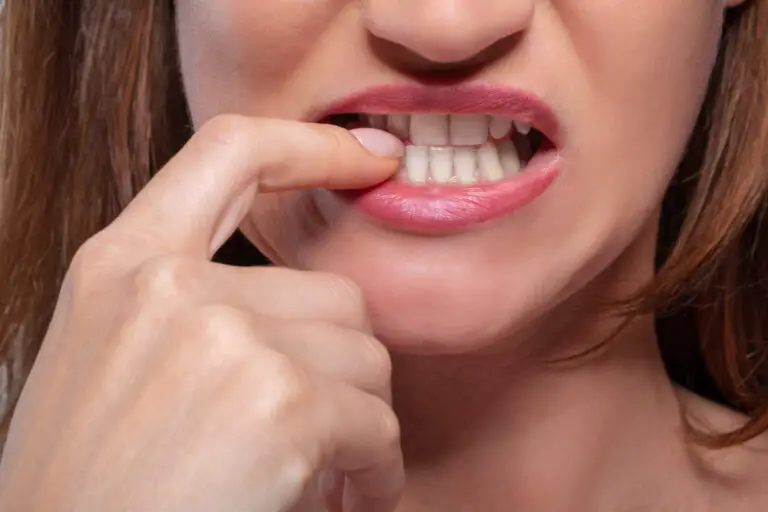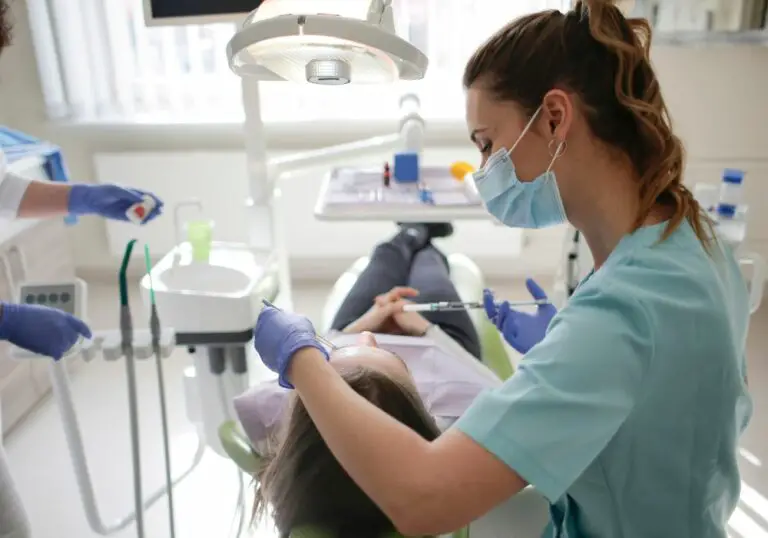What Exactly is a Cavity?
A cavity, also known as a carious lesion or dental caries, is a breakdown of the tooth’s surface caused by acidic byproducts from oral bacteria. Cavities form in the hard tissues of the teeth – the enamel, dentin, and cementum.
Enamel is the thin outer mineralized layer that covers and protects the tooth crown. It is the hardest substance in the human body. Underneath the enamel is dentin, a softer bone-like tissue that makes up the bulk of the tooth structure. The dentin surrounds the innermost pulp which houses the tooth’s nerves and blood vessels. The root of the tooth is covered by cementum, a bony tissue containing collagen fibers that anchor the tooth to the jawbone via the periodontal ligament.
When cavities form, the enamel is the first layer attacked by bacteria acids. As the cavity spreads, it penetrates through the enamel and into the softer dentin underneath. If left untreated, the decay can reach the innermost pulp tissue at the center of the tooth, causing severe pain and dental infections. Proper treatment is required to prevent cavities from worsening and destroying the tooth structure extensively.
What Factors Cause Cavities to Form?

There are four main contributing factors to cavity formation in the teeth:
1. Cariogenic Bacteria
Dental cavities are a diet-dependent infectious disease caused primarily by mutans streptococci and lactobacilli bacteria. These bacteria feed on fermentable carbohydrates like sugar and processed starch. As they metabolize carbohydrates, they produce lactic acid as a byproduct. The lactic acid strips minerals from the tooth enamel in a process called demineralization. Certain strains of oral bacteria are more cariogenic, or cavity-causing, than others due to their acid production and adhesion properties.
2. Frequent Exposure to Fermentable Carbs
When sugars or refined carbohydrates are frequently consumed and coat the teeth, the bacteria’s acid attacks are more frequent. This raises the risk for cavities. Sticky foods like candy, bread, pasta, and dried fruit cling to teeth longer, providing sustained “fuel” for bacteria. The greater the exposure to fermentable carbs throughout the day, the more prolonged the demineralizing acid attacks on the teeth become. Limiting sugary snacks and drinks to mealtimes allows “remineralization periods” to strengthen enamel.
3. Inadequate Oral Hygiene and Fluoride
Without proper daily plaque removal by brushing and flossing, bacteria colonies thrive in protected areas of the teeth. Plaque buildup provides a reservoir of acid-producing bacteria against the enamel. Fluoride strengthens enamel and prevents demineralization from bacterial acids. A lack of fluoride makes enamel more susceptible to decay. Together, poor oral hygiene and low fluoride exposure enable lesion development.
4. Impaired Saliva Quantity and Quality
Saliva helps buffer acids and provide calcium and phosphate ions to rebuild enamel through remineralization. It also washes away food debris. When saliva quantity or quality is compromised, such as with certain diseases, medications, radiation therapy, etc., the natural defenses against cavities weaken. Rampant decay often results under reduced saliva conditions. This is called radiation caries or dry mouth caries.
Can You Repair a Cavity Using Just Toothpaste?
Now that we have reviewed the tooth structure, caries process, and factors involved with cavity formation, we can address our original question – can toothpaste alone fix or repair an existing cavity?
The answer is no, toothpaste itself cannot properly fill, rebuild, or restore a carious lesion in the enamel or dentin. While toothpaste aids in cleaning the teeth and supplying some minerals, it does not contain actual restorative ingredients that fill cavities.
Toothpaste has three primary components:
- Abrasives like silicates and phosphates to clean and polish the teeth
- Fluoride to strengthen enamel and prevent cavities
- Detergents and foaming agents like sodium lauryl sulfate to enhance the cleaning effects
So toothpaste assists in plaque removal and fluoride delivery to protect against new cavities. But toothpaste lacks any resins, adhesives, or bonding agents needed to fill holes and rebuild lost tooth structure. Without proper bonding, any putative “filling” by toothpaste would quickly fall out, leaving the cavity open and unrestored.
While toothpaste alone cannot structurally repair existing decay, could it still potentially reverse or arrest early cavities before they progress? We’ll explore that next.
Can Toothpaste Heal Early Stage Cavities?

Detecting and treating cavities when they are small and shallow in the outer enamel gives the best chance of regenerating the tooth structure through remineralization. The fluoride in toothpaste supports remineralization in a few ways:
- Fluoride concentrates in plaque and saliva, which enhances remineralization of enamel crystals
- Fluoride gets incorporated into the crystal lattice of reformed hydroxyapatite crystals, making them more acid-resistant
- Fluoride inhibits bacterial fermentation and acid production
However, mild “white spot lesions” still require sufficient calcium and phosphate ions to rebuild the crystals damaged by acid. Typically, the low levels of minerals in saliva and toothpaste alone are insufficient to fully reharden more severe white spot cavities. But for very early demineralization, toothpaste may support some reversal if provided the proper minerals.
Specialized pastes like MI Paste contain casein phosphopeptide-amorphous calcium phosphate (CPP-ACP). The CPP binds to calcium and phosphate, keeping them in solution and donating the ions to promote remineralization of white spots. Combining these pastes with fluoride treatments greatly enhances the rehardening effects.
Still, any notable areas of demineralization or visible enamel breakdown indicate more advanced decay requiring professional dental attention. Toothpaste can only bolster the effects of traditional fluoride treatments, not substitute proper cavity repair.
Why Can’t You Just Fill Cavities With Toothpaste?
Applying toothpaste into a cavity may seem to act like a temporary filling, but it does not cure or properly restore the lesion. Here’s why toothpaste falls short:
1. Lacks bonding ability – Dental fillings contain adhesive resins that chemically bond to the tooth structure for retention. Toothpaste does not bond, leaving gaps where bacteria and debris can enter.
2. No strength for chewing forces – The abrasives in toothpaste are not strong enough to withstand compressive biting forces. The “filling” would quickly break down and fall out under pressure.
3. Does not halt decay – Toothpaste does not stop the caries process or form a sealed barrier to block out bacteria and acids. Decay would continue undermined the superficial paste.
4. No inhibition of bacteria – While toothpaste has mild antimicrobial activity, it does not contain strong bactericidal agents to sterilize the decayed area. Bacteria would remain alive under the paste.
5. No stimulation of remineralization – Dental fillings release ions to stimulate regrowth of mineral crystals. Toothpaste alone provides insufficient ions to remineralize a cavity.
6. Poor shade match – Toothpastes are rarely aesthetic enough to match surrounding tooth color and shade. This leaves an obvious, unaesthetic defective area.
In summary, while toothpaste may temporarily mask the hole visually, it does not functionally cure the cavity like a professionally placed dental filling does. Proper restoration of decay requires durable, sealed fillings that inhibit bacteria, promote remineralization, and restore strength and appearance.
Effective Professional Treatments for Cavities

When cavities are detected, either through symptoms, visual inspection, or x-rays, prompt treatment by a dentist is required to prevent further destruction of the tooth structure. Based on the location, size, and depth of the decay, cavities are treated by the dentist using one of these approaches:
Dental Fillings
Fillings entail removing all the decayed material and then filling the prepared cavity with a synthetic material to restore form and function. The most common types of dental fillings include:
- Amalgam – A stable alloy of mercury, silver, tin, copper, and zinc. Amalgams have good strength and longevity but lack natural tooth color.
- Composite – A resin consisting of fine glass filler particles bound in a plastic matrix and cured by light activation. Composites match the tooth color but aren’t as durable as amalgam.
- Glass ionomer – Made of acrylic acid and glass particles that set via a chemical reaction. These release fluoride but aren’t very strong.
- Gold – Gold alloy castings for inlays, onlays, and crowns. Gold is highly biocompatible and wears well but is more costly.
Dental Crowns
When cavities are too large for a filling or the tooth is weakened by decay, dental crowns may be needed. Crowns cap the entire visible portion of the tooth to restore form and function. Crowns are made of stronger materials like porcelain-fused-to-metal, zirconium, or ceramic to withstand the forces of biting and chewing.
Root Canal Therapy
For extensive decay invading the inner pulp tissue, root canal treatment is required. This removes the infected pulp, cleans and shapes the interior canals, then seals the disinfected space. Afterwards, a dental crown is placed to protect the tooth. This preserves severely decayed teeth from extraction.
Can You Make Toothpaste More Effective Against Cavities?
While no toothpaste can functionally fill cavities, selecting a product optimized to strengthen and remineralize enamel can enhance preventative effects. Look for these helpful ingredients:
- 5,000 ppm fluoride – Higher fluoride concentration boosts remineralization.
- Nano-hydroxyapatite – Small particles help fill microscopic defects in enamel.
- Xylitol – This sugar alcohol inhibits the cariogenic oral bacteria.
- Argon/calcium/sodium – Forms a protective layer blocking sensitivity and acid diffusion.
- CPP-ACP – Calcium phosphate reservoir aids remineralization of white spot lesions.
- Antimicrobials like chlorhexidine and triclosan fight bacteria.
Ask your dentist for prescription-strength specialty toothpaste to maximize cavity protection and enamel strengthening. This can help mitigate cavities between dental visits but does not remove the need for professional assessment and intervention when decay is present.
When to See a Dentist About a Cavity
Don’t try to self-treat an existing cavity with toothpaste. Seek professional help when you notice these signs:
- Tooth pain or sensitivity, especially with sweet foods
- Visible holes or pits in enamel
- Brown or white spots on teeth
- Changes in tooth shape from erosion
- Exposed darker inner dentin through enamel
- Loose pieces or breakdown of a tooth
The dentist will diagnose the decay using visual inspection, dental x-rays, and tactile probing. Based on the assessment of cavity size, depth, and pulp involvement, the dentist will provide the appropriate treatment to restore your teeth. Don’t delay treatment, as waiting allows more destruction, possibly requiring more complex solutions or extraction down the line. Save your natural teeth by getting cavities professionally treated promptly.
Conclusion
While toothpaste can help strengthen enamel against acid attacks, it does not contain adequate filling and bonding agents to functionally repair cavities and decayed tooth structure. Seeking professional dental care is critical to properly treat existing lesions and restore damaged areas. Dentists have the tools and materials like dental fillings, crowns, and root canals to effectively fix cavities based on their severity. Using therapeutic toothpaste optimized with remineralizing ingredients can support preventative efforts between dental visits but should never serve as a substitute for proper restorative intervention when decay has set in. Maintain diligent daily oral hygiene plus regular dental cleanings and exams to catch cavities early and preserve your natural teeth for life.







